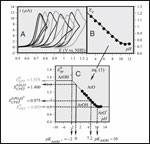Publication
653
PNAS
106, 18143–18148, 2009.
DOI: 10.1073/pnas.0910065106
|
|
|
|
|
 |
The electrochemical approach to concerted proton—electron transfers in the oxidation of phenols in water |
|
|
|
|
|
Cyrille Costentin, Cyril Louault, Marc Robert and Jean-Michel Savéant
Laboratoire d'Electrochimie Moléculaire, Université Paris Diderot, UMR CNRS 7591, 15, rue Jean-Antoine de Baïf, 75205 Paris Cedex 13, France
Establishing mechanisms and intrinsic reactivity in the oxidation of phenol with water as the proton acceptor is a fundamental
task relevant to many reactions occurring in natural systems. Thanks to the easy measure of the reaction kinetics by the current
and the setting of the driving force by the electrode potential, the electrochemical approach is particularly suited to this
endeavor. Despite challenging difficulties related to self-inhibition blocking the electrode surface, experimental conditions
were established that allowed a reliable analysis of the thermodynamics and mechanisms of the proton-coupled electron-transfer
oxidation of phenol to be carried out by means of cyclic voltammetry. The thermodynamic characterization was conducted in
buffer media whereas the mechanisms were revealed in unbuffered water. Unambiguous evidence of a concerted proton–electron
transfer mechanism, with water as proton acceptor, was thus gathered by simulation of the experimental data with appropriately
derived theoretical relationships, leading to the determination of a remarkably large intrinsic rate constant. The same strategy
also allowed the quantitative analysis of the competition between the concerted proton–electron transfer pathway and an OH--triggered stepwise pathway (proton transfer followed by electron transfer) at high pHs. Investigation of the passage between
unbuffered and buffered media with the example of the PO4H2-/PO4H2- couple revealed the prevalence of a mechanism involving a proton transfer preceding an electron transfer over a PO4H2--triggered concerted process. |

